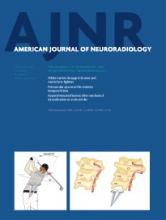Research ArticleNeurointervention
Open Access
Quantifying the Large-Scale Hemodynamics of Intracranial Aneurysms
G. Byrne, F. Mut and J. Cebral
American Journal of Neuroradiology February 2014, 35 (2) 333-338; DOI: https://doi.org/10.3174/ajnr.A3678
G. Byrne
aFrom the Center for Computational Fluid Dynamics, College of Science, George Mason University, Fairfax, Virginia.
F. Mut
aFrom the Center for Computational Fluid Dynamics, College of Science, George Mason University, Fairfax, Virginia.
J. Cebral
aFrom the Center for Computational Fluid Dynamics, College of Science, George Mason University, Fairfax, Virginia.

Submit a Response to This Article
Jump to comment:
No eLetters have been published for this article.
In this issue
American Journal of Neuroradiology
Vol. 35, Issue 2
1 Feb 2014
Advertisement
G. Byrne, F. Mut, J. Cebral
Quantifying the Large-Scale Hemodynamics of Intracranial Aneurysms
American Journal of Neuroradiology Feb 2014, 35 (2) 333-338; DOI: 10.3174/ajnr.A3678
Jump to section
Related Articles
- No related articles found.
Cited By...
- Aneurysmal Growth in Type-B Aortic Dissection: Assessing the Impact of Patient-Specific Inlet Conditions on Key Haemodynamic Indices
- The impact of patient-specific inlet conditions on oscillatory shear and helicity in haemodynamic simulations of aneurysmal Type-B Aortic Dissection
- Towards Reduced Order Models via Robust Proper Orthogonal Decomposition to Capture Personalised Aortic Haemodynamics
- Identification of Vortex Cores in Cerebral Aneurysms on 4D Flow MRI
- Novel Models for Identification of the Ruptured Aneurysm in Patients with Subarachnoid Hemorrhage with Multiple Aneurysms
- Hemodynamic characteristics of stable and unstable vertebrobasilar dolichoectatic and fusiform aneurysms
- Hemodynamic Characteristics of Ruptured and Unruptured Multiple Aneurysms at Mirror and Ipsilateral Locations
- Angioarchitectures and Hemodynamic Characteristics of Posterior Communicating Artery Aneurysms and Their Association with Rupture Status
- Hemodynamic differences between unstable and stable unruptured aneurysms independent of size and location: a pilot study
- Differences in Hemodynamics and Rupture Rate of Aneurysms at the Bifurcation of the Basilar and Internal Carotid Arteries
- Clinical, morphological, and hemodynamic independent characteristic factors for rupture of posterior communicating artery aneurysms
- Hemodynamics in growing and stable cerebral aneurysms
- Hemodynamic analysis of fast and slow aneurysm occlusions by flow diversion in rabbits
- Wall Mechanical Properties and Hemodynamics of Unruptured Intracranial Aneurysms
- Association between hemodynamic conditions and occlusion times after flow diversion in cerebral aneurysms
- Toward Improving Fidelity of Computational Fluid Dynamics Simulations: Boundary Conditions Matter
- Generalized versus Patient-Specific Inflow Boundary Conditions in Computational Fluid Dynamics Simulations of Cerebral Aneurysmal Hemodynamics
This article has not yet been cited by articles in journals that are participating in Crossref Cited-by Linking.
More in this TOC Section
Similar Articles
Advertisement











